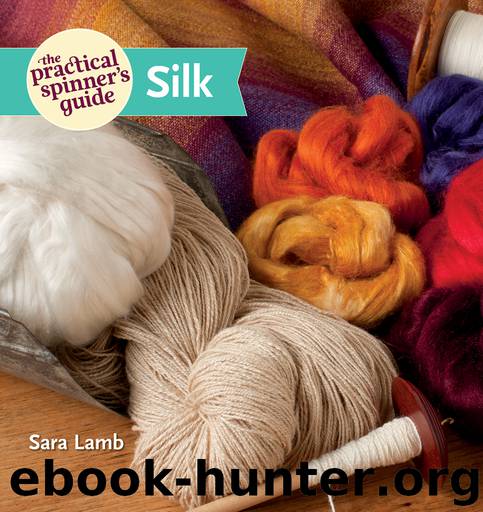The Practical Spinner's Guide--Silk by Sara Lamb

Author:Sara Lamb
Language: eng
Format: epub
Publisher: F+W Media
The black yarn and the black-and-white samples in the upper right show the undamaged silk after it had been heated while dyed with acid dyes. The multicolored scarf in the foreground has a faded, rough, and worn look caused by overdyeing the silk by heating it in an alkaline solution.
Natural Dyes
Natural dye substances have been used for both immersion dyeing and painting on silk for centuries. However, most of the fixatives (called mordants) used with natural dyes are alkaline, so the temperatures at which the dyes are fixed should be kept as low as possible.
Sodium hydrosulfite, lye, or ammonia are typically used as reducing agents for indigo dyeing. All of these are alkaline substances that are corrosive to silk. Take care to use them in sufficient, but not excessive, amounts and to use a low temperature range. Consult natural-dye books (see Resources) for information.
Potassium aluminum (alum) is another alkaline substance that should be used sparingly with silk. Alum mordant can be used for many natural-dye substances, such as madder, onion skins, and coreopsis flowers. It’s usually used in a pre-mordant bath before immersion into a dyebath or before painting the fiber or yarn.
Download
This site does not store any files on its server. We only index and link to content provided by other sites. Please contact the content providers to delete copyright contents if any and email us, we'll remove relevant links or contents immediately.
On Writing A Memoir of the Craft by Stephen King(4655)
The Doodle Revolution by Sunni Brown(4496)
A Simplified Life by Emily Ley(3962)
Mummy Knew by Lisa James(3516)
Marijuana Grower's Handbook by Ed Rosenthal(3508)
Better Homes and Gardens New Cookbook by Better Homes & Gardens(3363)
Paper Parties by Erin Hung(3305)
Figure Drawing for Artists by Steve Huston(3266)
Draw Your Day by Samantha Dion Baker(3121)
The Genius of Japanese Carpentry by Azby Brown(3032)
Japanese Design by Patricia J. Graham(2995)
The Code Book by Simon Singh(2852)
Lions and Lace by Meagan Mckinney(2841)
Dangerous Girls by Haas Abigail(2836)
The Curated Closet by Anuschka Rees(2797)
How to Make Your Own Soap by Sally Hornsey(2739)
The Checklist Manifesto by Atul Gawande(2652)
The Wardrobe Wakeup by Lois Joy Johnson(2632)
Zero to Make by David Lang(2618)
